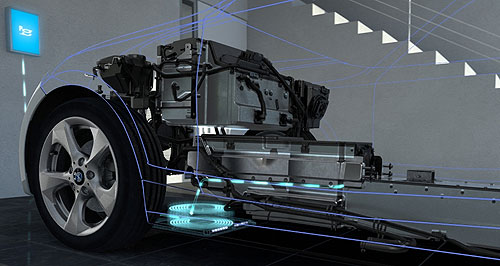Make / Model Search
News - BMWBMW charges EVs without cablesIn hybrid: With indcutive alternating magnetic fields, BMW's contactless charging technology takes the plug out of plug-in hybrid. Daimler pairs-up with BMW to develop inductive EV and hybrid chargingGallery Click to see larger images 10 Jul 2014 BMW is developing technology that it says will make the use of plug-in electric and hybrid vehicles even simpler and more attractive by taking away the plug. In a joint venture with Daimler, the German car-maker is exploring hardware that inductively charges EV batteries without the need for cables or any kind of physical contact with the power source. The system simply requires the vehicle to be parked in the correct position over a primary charging coil, which then sends power to the secondary coil at an efficiency rate of over 90 per cent. A WiFi connection between the charge point and the car assists the driver with positioning the vehicle easily, and once parked, charging starts at the touch of a button. While the vehicle is refuelling, its charge-status and time to full-charge can be monitored remotely with the use of a smart-phone application. Trials of the cordless charging system with BMW's high-tech i8 sports car have allowed a full charge in less than two hours, and with a charge-rate of 3.6 kilowatts, BMW says an average hybrid can be charged in less than three hours. With further development, a rate of up to 7kW could be permitted, cutting charge times even further. Wireless charging may prove to be more convenient, but by removing the trip-hazard of loose cables and live electrical connections, the systems could be safer to use too – not to mention neater. The technology works on the same principle as existing mobile-phone and other small battery-operated device’s wireless charging, but the BMW system deals with much higher current and voltage. Currently the only option BMW offers for rapid charging is the “i Wallbox”, which requires a high-current cord to be plugged into the vehicle, but by collaborating with Daimler, a more standardised system will result. This means other manufacturers may decide to buy-in to the technology (in much the same way the USB connection was adopted by manufacturers of small electronics), ultimately allowing a variety of different branded EVs to charge on a single type of parking space. The hardware required to allow contactless charging consists mainly of two low-profile coils, which are easily installed into both the underside of the vehicle and the floor of a garage for example. Therefore no extensive modifications are required to existing vehicle structures, and retrofitting may also be a possibility in the future. BMW is not alone in developing non-contact charging technology, with fellow automotive giants Volvo, Nissan, Renault and Toyota all having recently produced prototypes.  Read more |
Click to shareBMW articlesResearch BMW Motor industry news |





















Facebook Twitter Instagram